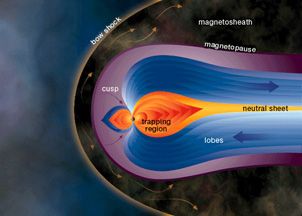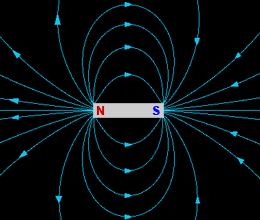Bar magnets have two poles. They produce dipole magnetic fields. Magnetic fields can have more than two poles - quadrupole fields have four.
Click on image for full size
Original artwork by Windows to the Universe staff (Randy Russell).
Dipole, Quadrupole, and Multipole Magnetic Fields
You are probably familiar with bar magnets. Bar magnets have two magnetic poles - north and south. The magnetic field around a bar magnet is called a dipole ("two poles") magnetic field. Bar magnets are not the only objects capable of creating dipole fields. Electricity flowing through a coiled wire can generate a dipole magnetic field. The magnetic fields of some planets, including Earth, are "more or less" dipole fields.
Dipoles are not the only shape magnetic fields come in. Quadrupole fields (four poles) are fairly common. Sometimes magnetic fields have six or even eight poles (an octupole!). Any field with more than two poles is called a multipole field.
Many astronomical objects have magnetic fields that are pretty much dipoles. However, some objects have complex magnetic fields that are a combination of a dipole and one or more multipole fields. The magnetic fields of Earth and Jupiter are strongly dipolar, with only minor multipole contributions. However, the quadrupole elements of the magnetic fields of Uranus and Neptune are similar in strength to their dipole portions.
You might also be interested in:

The force of magnetism causes material to point along the direction the magnetic force points. This property implies that the force of magnetism has a direction. As shown in the diagram to the left, the
...more
The Earth is a good example of a planetary dipole, where the lines of force point in a direction out of the South (magnetic) Pole and into the North (magnetic) Pole. Planets can also show evidence of quadrupoles
...more
Jupiter's magnetosphere is a unique object in the solar system. It is the biggest object in the entire solar system. Not only is it big enough to contain all of Jupiter's moons, but the sun itself could
...more
The magnetosphere of Uranus is medium sized, but still much larger than the Earth's. It extends well beyond the orbits of Uranus' moons. It is probably generated in the icy interior layers, rather than
...more
The planet Uranus has an odd magnetic field. The planet's magnetic poles are nowhere near the geographic poles (as defined by the spin axis) of Uranus. A portion of the magnetic field of Uranus is a dipole
...more
The Sun has a very large and very complex magnetic field. The magnetic field at an average place on the Sun is around 1 Gauss, about twice as strong as the average field on the surface of Earth (around
...more
Mercury has a weak magnetic field. Like Earth's magnetic field, Mercury's dipole field is tilted with respect to the planet's spin axis. This means that Mercury's magnetic poles and its geographic poles
...more















